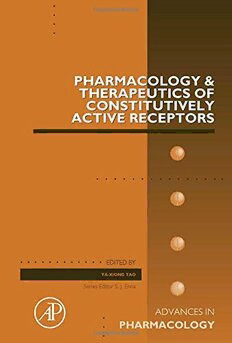
Pharmacology & Therapeutics of Constitutively Active Receptors : PDF
Preview Pharmacology & Therapeutics of Constitutively Active Receptors :
AcademicPressisanimprintofElsevier 525BStreet,Suite1800,SanDiego,CA92101-4495,USA 225WymanStreet,Waltham,MA02451,USA 32,JamestownRoad,LondonNW17BY,UK TheBoulevard,LangfordLane,Kidlington,Oxford,OX51GB,UK Radarweg29,POBox211,1000AEAmsterdam,TheNetherlands Firstedition2014 Copyright©2014ElsevierInc.Allrightsreserved Nopartofthispublicationmaybereproduced,storedinaretrievalsystemortransmitted inanyformorbyanymeanselectronic,mechanical,photocopying,recordingorotherwise withoutthepriorwrittenpermissionofthepublisher PermissionsmaybesoughtdirectlyfromElsevier’sScience&TechnologyRights DepartmentinOxford,UK:phone(+44)(0)1865843830;fax(+44)(0)1865 853333; email:permissions@elsevier.com.Alternativelyyoucansubmityourrequestonlineby visitingtheElsevierwebsiteathttp://elsevier.com/locate/permissions,andselecting ObtainingpermissiontouseElseviermaterial. Notice Noresponsibilityisassumedbythepublisherforanyinjuryand/ordamagetopersonsor propertyasamatterofproductsliability,negligenceorotherwise,orfromanyuseor operationofanymethods,products,instructionsorideascontainedinthematerialherein. Becauseofrapidadvancesinthemedicalsciences,inparticular,independentverificationof diagnosesanddrugdosagesshouldbemade BritishLibraryCataloguing-in-PublicationData AcataloguerecordforthisbookisavailablefromtheBritishLibrary LibraryofCongressCataloging-in-PublicationData AcatalogrecordforthisbookisavailablefromtheLibraryofCongress ISBN:978-0-12-417197-8 ISSN:1054-3589 ForinformationonallAcademicPresspublications visitourwebsiteatstore.elsevier.com PrintedandboundinUnitedStatesinAmerica 14 15 16 10 9 8 7 6 5 4 3 2 1 PREFACE Constitutiveactivity,whichissignalingintheabsenceofagonists,wasfirst describedinearly1980sinthetypeAg-aminobutyricreceptor,anionchan- nel.Therecordingofasingleionchannelshowedthatitcan,indeed,open intheabsenceofanagonist.Ligandsthatdecreasetheelevatedbasalactivity were then described for these receptors. Very quickly, studies from Nobel Laureate Robert Lefkowitz’s laboratory showed that G protein-coupled receptors (GPCRs) could couple to G proteins in the absence of ligands, at least in reconstituted systems. Finally in 1989, Costa and Herz demon- strated in neuroblastoma cells expressing d-opioid receptors endogenously, thereissignificantbasalactivitywhichcanbedecreasedbysomeantagonists, theso-called“negativeantagonists,”nowcommonlyreferredtoas“inverse agonists.” Followingthesepioneeringstudies,togetherwiththecloningofnumer- ousGPCRsandtheirheterologousexpressionincelllines,severalimportant discoveries were made. Mutations generated by site-directed mutagenesis cancausesignificantincreaseinbasalactivity,presumablybybreakinginter- actions that constrain the wild-type receptor in inactive conformation. Numerous studies utilized this strategy to gain insights into the structure of GPCRs before the crystal structures of GPCRs were reported. Other studies used these data, together with homology modeling, after some of the crystal structures of GPCRs began to appear in the literature. Some wild-typereceptorshavesignificantbasalactivity,whichcanbedramatically differentevenbetweencloselyrelatedreceptors.Naturallyoccurringmuta- tions in several GPCRs that either increase or decrease basal activity can cause significant human diseases, including cancer. Highly constitutively active GPCRs in viruses also cause human diseases. Transgenic animals expressing constitutively active mutant receptors present phenotypes that suggest constitutive activity has physiological relevance in vivo. Receptor theory was modified to account for the constitutive activity. A look back atthedrugsthattargetGPCRsindeedrevealthatthemajorityoftheantag- onistsareinverseagonists,notneutralantagonists.Thesearejustsomeofthe major advances and the field is still rapidly expanding. Inthisvolume,wetriedtocaptureaglimpseofrecentprogressinseveral selectedGPCRs.Theofferingsincludenotonlyrhodopsin,oneofthemost extensively studied and the first example of genetic mutations causing ix x Preface human disease, but also the glycoprotein hormone receptors, the cannabi- noidreceptor,themelanocortin-4receptor,theangiotensintype1receptor, the dopamine receptors, the chemokine receptors, and a chemosensory receptor, the bitter taste receptor. We also recruited a chapter on the constitutive activity of a nuclear receptor, the androgen receptor, and two chapters on ion channels. IthankDr.S.J.Enna,theSeriesEditor,forhissupportforthisvolume, and Ms. Lynn LeCount, the Managing Editor, for everything she did to make sure this volume moves along as scheduled. I am very grateful to all the contributors, who are all busy scientists with numerous commitments, for taking the time to write their excellent contributions. I anticipate this volumewillstimulatefurtherresearchinthisfascinatingfieldofconstitutive activity. YA-XIONG TAO Department of Anatomy, Physiology and Pharmacology, College of Veterinary Medicine, Auburn University, Auburn, Alabama, USA Volume 70 Editor CONTRIBUTORS IssamAbu-Taha FacultyofMedicine,InstituteofPharmacology,UniversityDuisburg-Essen,Essen,Germany AwatifAlbaker OttawaHospitalResearchInstitute(NeuroscienceProgram),andDepartmentsofMedicine, Cellular&MolecularMedicine,Psychiatry,UniversityofOttawa,Ottawa,Ontario,Canada RajinderP.Bhullar DepartmentofOralBiology,UniversityofManitoba,Winnipeg,Manitoba,Canada HeikeBiebermann InstituteofExperimentalPediatricEndocrinology,Charite´-Universita¨tsmedizinBerlin, Berlin,Germany GeorgeBousfield StudiumConsortiumforResearchandTraininginReproductiveSciences(sCORTS), Tours,France,andDepartmentofBiologicalSciences,WichitaStateUniversity,Wichita, Kansas,USA SiuChiuChan MasonicCancerCenter,UniversityofMinnesota,Minneapolis,Minnesota,USA PrashenChelikani DepartmentofOralBiology,UniversityofManitoba,Winnipeg,Manitoba,Canada ScottM.Dehm MasonicCancerCenter,andDepartmentofLaboratoryMedicineandPathology,University ofMinnesota,Minneapolis,Minnesota,USA JamesA.Dias StudiumConsortiumforResearchandTraininginReproductiveSciences(sCORTS), Tours,France,andDepartmentofBiomedicalSciences,SchoolofPublicHealth,University atAlbany,Albany,NewYork,USA DobromirDobrev FacultyofMedicine,InstituteofPharmacology,UniversityDuisburg-Essen,Essen,Germany ColleenA.Flanagan SchoolofPhysiologyandMedicalResearchCouncilReceptorBiologyResearchUnit, FacultyofHealthSciences,UniversityoftheWitwatersrand,PrivateBag3,Wits,South Africa TungM.Fong ForestResearchInstitute,JerseyCity,NewJersey,USA XinbingHan BostonChildren’sHospital,HarvardMedicalSchool,Boston,Massachusetts,USA xi xii Contributors JordiHeijman FacultyofMedicine,InstituteofPharmacology,UniversityDuisburg-Essen,Essen,Germany IlpoHuhtaniemi StudiumConsortiumforResearchandTraininginReproductiveSciences(sCORTS), Tours,France,andInstituteofReproductiveandDevelopmentalBiology,ImperialCollege London,London,UnitedKingdom SadashivaS.Karnik DepartmentofMolecularCardiology,LernerResearchInstitute,ClevelandClinic, Cleveland,Ohio,USA GunnarKleinau InstituteofExperimentalPediatricEndocrinology,Charite´-Universita¨tsmedizinBerlin, Berlin,Germany CarolineLefebvre OttawaHospitalResearchInstitute(NeuroscienceProgram),andDepartmentsof Medicine,Cellular&MolecularMedicine,Psychiatry,UniversityofOttawa,Ottawa, Ontario,Canada DoriMiller DepartmentofAnatomy,Physiology&Pharmacology,CollegeofVeterinaryMedicine, AuburnUniversity,Auburn,Alabama,USA PaulShin-HyunPark DepartmentofOphthalmologyandVisualSciences,CaseWesternReserveUniversity, Cleveland,Ohio,USA BiancaPlouffe DepartmentofBiochemistry,Universite´ deMontre´al,andInstitutderechercheen immunologie,cancer,Montre´al,Que´bec,Canada SaiP.Pydi DepartmentofOralBiology,UniversityofManitoba,Winnipeg,Manitoba,Canada EricReiter StudiumConsortiumforResearchandTraininginReproductiveSciences(sCORTS); BIOSGroup,INRA,UMR85,Unite´ PhysiologiedelaReproductionetdes Comportements;CNRS,UMR7247,Nouzilly,andUniversite´ Franc¸oisRabelais,Tours, France Ya-XiongTao DepartmentofAnatomy,PhysiologyandPharmacology,CollegeofVeterinaryMedicine, AuburnUniversity,Auburn,Alabama,USA MarioTiberi OttawaHospitalResearchInstitute(NeuroscienceProgram),andDepartmentsof Medicine,Cellular&MolecularMedicine,Psychiatry,UniversityofOttawa,Ottawa, Ontario,Canada Contributors xiii AlfredoUlloa-Aguirre StudiumConsortiumforResearchandTraininginReproductiveSciences(sCORTS), Tours,France,andResearchSupportNetwork,InstitutoNacionaldeCienciasMe´dicasy Nutricio´n“SalvadorZubira´n”andUniversidadNacionalAuto´nomadeMe´xico,Me´xico D.F.,Mexico HamiyetUnal DepartmentofMolecularCardiology,LernerResearchInstitute,ClevelandClinic, Cleveland,Ohio,USA NielsVoigt FacultyofMedicine,InstituteofPharmacology,UniversityDuisburg-Essen,Essen,Germany LiliWang DepartmentofAnatomy,Physiology&Pharmacology,CollegeofVeterinaryMedicine, AuburnUniversity,Auburn,Alabama,USA BoyangZhang OttawaHospitalResearchInstitute(NeuroscienceProgram),andDepartmentsofMedicine, Cellular&MolecularMedicine,Psychiatry,UniversityofOttawa,Ottawa,Ontario,Canada JumingZhong DepartmentofAnatomy,Physiology&Pharmacology,CollegeofVeterinaryMedicine, AuburnUniversity,Auburn,Alabama,USA CHAPTER ONE Constitutively Active Rhodopsin and Retinal Disease Paul Shin-Hyun Park1 DepartmentofOphthalmologyandVisualSciences,CaseWesternReserveUniversity,Cleveland,Ohio,USA 1Correspondingauthor:e-mailaddress:[email protected] Contents 1. Introduction 2 2. RhodopsinActivity 5 2.1 Physiologyofrhodopsinactivity 5 2.2 Molecularswitchesthatlockrhodopsininaninactivestate 10 3. ConstitutiveActivityinRhodopsinthatCausesDisease 12 3.1 LebercongenitalamaurosisandvitaminAdeficiency 12 3.2 Congenitalnightblindness 15 3.3 Retinitispigmentosa 19 4. HowConstitutiveActivityCanCauseDifferentPhenotypes 22 4.1 Differentlevelsofactivityasanunderlyingcauseofdifferentphenotypes 22 4.2 Doallconstitutivelyactivemutantsadoptthesameactive-state conformation? 23 5. Conclusion 26 ConflictofInterest 27 Acknowledgments 27 References 27 Abstract Rhodopsinisthelightreceptorinrodphotoreceptorcellsoftheretinathatinitiatessco- topicvision.Inthedark,rhodopsinisboundtothechromophore11-cisretinal,which locksthereceptorinaninactivestate.Themaintenanceofaninactiverhodopsininthe darkiscriticalforrodphotoreceptorcellstoremainhighlysensitive.Perturbationsby mutationortheabsenceof11-cisretinalcancauserhodopsintobecomeconstitutively active,whichleadstothedesensitizationofphotoreceptorcellsand,insomeinstances, retinaldegeneration.Constitutiveactivitycanariseinrhodopsinbyvariousmechanisms andcancauseavarietyofinheritedretinaldiseasesincludingLebercongenitalamau- rosis,congenitalnightblindness,andretinitispigmentosa.Inthisreview,themolecular andstructuralpropertiesofdifferentconstitutivelyactiveformsofrhodopsinareover- viewed,andthepossibilitythatconstitutiveactivitycanarisefromdifferentactive-state conformationsisdiscussed. AdvancesinPharmacology,Volume70 #2014ElsevierInc. 1 ISSN1054-3589 Allrightsreserved. http://dx.doi.org/10.1016/B978-0-12-417197-8.00001-8 2 PaulShin-HyunPark ABBREVIATIONS CNB congenitalnightblindness CP cytoplasmicloop EC extracellularloop EPR electronparamagneticresonance GPCR Gprotein-coupledreceptor H8 amphipathicalphahelix8 LCA Lebercongenitalamaurosis LRAT lecithinretinolacyltransferase MI metarhodopsinI MII metarhodopsinII R inactivestate * R activestate RIS rodinnersegment(s) ROS rodoutersegment(s) RP retinitispigmentosa RPE65 retinalpigmentepithelium-specific65kDaprotein TM transmembranealphahelix l maximalabsorbanceoflight max 1. INTRODUCTION Rhodopsin is a member of the G protein-coupled receptor (GPCR) familyofmembraneproteins.BovinerhodopsinwasthefirstGPCRtohave its primary, secondary, and tertiary structures determined (Hargrave et al., 1983; Nathans & Hogness, 1983; Ovchinnikov Yu, 1982; Palczewski et al., 2000; Schertler, Villa, & Henderson, 1993). These studies revealed astructurewithseventransmembranealphahelices(TM1–TM7)connected by extracellular (EC1–EC3) and cytoplasmic (CP1–CP3) loops and an amphipathic alpha helix (H8) that sits parallel to the membrane surface (Fig. 1.1). The human gene for rhodopsin was isolated and sequenced in themid-1980s(Nathans&Hogness,1984).Therhodopsingeneisahotspot for inherited mutations causing retinal disease (Mendes, van der Spuy, Chapple, & Cheetham, 2005; Nathans, Merbs, Sung, Weitz, & Wang, 1992; Stojanovic & Hwa, 2002). Rhodopsinisthelightreceptorthatinitiatesscotopicvisioninrodphoto- receptorcellsoftheretinauponphotoncapture.Thereceptorisembeddedata high concentration in disk membranes of rod outer segments (ROS) (Fig.1.2A).Intenseeffortstounderstandthestructureandfunctionofthislight receptorhavebeenongoingforquitesometime,especiallyaftertheinitialdis- covery that a single point mutation in the rhodopsin gene causes retinitis pigmentosa(RP)(Dryjaetal.,1990),aretinaldegenerativedisease.Evenwith ConstitutivelyActiveRhodopsin 3 ECAxyttroapclaesllumlaicr 56MYPWL00YLPTL4QVLLI0GMEMTHNTAFIAQF1FLKVSVFALK3Y809VATG00GLDLNTTYYMSLH1ARGMLI0YFQ0FNTLTYVL2PVLPLLFS70FY1WGL3LIVEPF0IVTG1GESE2VAMATFL0CRGGLS1VLPT3A 1SNCKYVSEF0 CG1P4RI1S01GMM2PH7G9VD00AF0ATWCMVNASYVMALLQSW1ELAING5Y 4VAP10RGGAT6CFTR0TFYE22AVLFI13I1MPFVIK00T8GNNVNHK0ICTPMFVEQ2EPSEFII0FYMLV5A02SFVFYT20APVKRFVITAKAILTWHQFVTA1YQVYEM0FQMCVVTI2MFQAP56A2222G0YET6S8I7I4NQ0000AS3SE3PTPKP01FN0I0TG2GIISVI9MFNYFM0MMF1EKPAIANN7TQFMNGYAARHN2MCL3T3D0TIG3C2L0CPGNK B D HOOCAPAVQSTE34T0KSVTASAE Figure 1.1 Structureofrhodopsin.(A)Thesecondarystructureofhumanrhodopsinis shown with residues causing constitutive activity and retinal disease when mutated, highlighted in black (Gly90, Thr94, Ser186, Asp190, Ala292, and Ala295), except for Lys296.Residuesformingmolecularswitchesarecoloredasfollows:green(darkgrayin theprintversion;Glu113,Glu181,andLys296),protonatedSchiffbaseswitch;yellow(very lightgrayintheprintversion;Cys264,Trp265,Pro267,andAla269),CWxPmotifswitch; cyan(light grayintheprint version;Glu122,Trp126,and His211),TM3–TM5 hydrogen bond network switch; blue (dark gray in the print version; Asn55, Asp83, Ala298, Ala299,Asn302,Pro303,Tyr306,andPhe313),NPxxYmotifswitch;red(darkgrayinthe printversion;Glu134,Arg135,Tyr136,Glu247,anThr251),D(E)RYmotifswitch.Residues formingtheCWxP,NPxxY,andD(E)RYmotifsarehighlightedinbold.(B)Crystalstructures oftheinactivestateofbovinerhodopsin(colored,PDB:1U19)andtheMIIstateofbovine rhodopsin (gray, PDB: 3PXO) were aligned with PyMOL. Residues causing constitutive activityandretinaldiseasewhenmutatedaredepictedasblackspheres.11-cisRetinal isdepictedaspinkspheres.Helicesintheinactive-statestructurearecoloredasfollows: blue(darkgrayintheprintversion),TM1;cyan(lightgrayintheprintversion),TM2;green (darkgrayintheprintversion),TM3;limegreen(grayintheprintversion),TM4;yellow (verylightgrayintheprintversion),TM5;orange(darkgrayintheprintversion),TM6; red(darkgrayintheprintversion),TM7;purple(darkgrayintheprintversion),H8. theseefforts,themechanisticdescriptionofrhodopsinactivityisincomplete. Sincetheinitialdiscovery,morethan100pointmutationshavebeendiscov- eredintherhodopsingenethatcauseretinaldisease(Garriga&Manyosa,2002; Mendesetal.,2005;Nathansetal.,1992;Stojanovic&Hwa,2002). Undernormalfunction,rhodopsiniscovalentlyboundto11-cisretinaland isinactiveinthedark(Fig.1.2B).Rhodopsinmustbeactivatedbylighttoini- tiatevision.Constitutiveactivityinrhodopsin(i.e.,receptoractivationinthe absence oflight stimulation)can arise because ofmutation ortheabsenceof bound11-cisretinalandcancausearangeofinheritedretinaldiseasesincluding Lebercongenitalamaurosis(LCA),congenitalnightblindness(CNB),andRP (Rao, Cohen, & Oprian, 1994; Robinson, Cohen, Zhukovsky, & Oprian, 4 PaulShin-HyunPark A Rod photoreceptor cell Dark Light Transducin Arrestin Outer segment Inner segment/perinuclear region B Rhodopsin MII Light Light Rho MII MII MII Ops γ α β P P P Arr GTPGDP 11-cis Retinal Figure1.2 Rodphotoreceptorcellsandphototransduction.(A)Cartoondepictionofa rodphotoreceptorcell.Thecartoonofthecellontheleftshowsthestructureofarod photoreceptorcellwithdiskmembranesintheROSandmitochondria,Golgiapparatus, endoplasmicreticulum,andnucleusintheRIS/perinuclearregion.Rhodopsinisembed- dedindiskmembranesoftheoutersegment.Thecartoonsofthecellinthemiddleand on the right illustrate the levels of transducin (green; gray in the print version) and arrestin(blue;blackintheprintversion)intheROSandRIS/perinuclearregioninthe dark and in the light. (B) Life cycle of rhodopsin. Rhodopsin is covalently bound to 11-cisretinalinthedark.Lightisomerizes11-cisretinaltoall-transretinal,whichpro- motestheactivationofrhodopsinandformationoftheMIIstate.MIIbindsandactivates theheterotrimericGproteintransducin(green;lightgrayintheprintversion)toinitiate phototransduction.MIIisinactivatedviaphosphorylationbyrhodopsinkinaseandthe bindingofarrestin(blue;darkgrayintheprintversion).TheMIIstatedecaystoopsin upon release of all-trans retinal from the chromophore-binding pocket. Opsin must reconstitutewith11-cisretinaltoregeneraterhodopsin.
